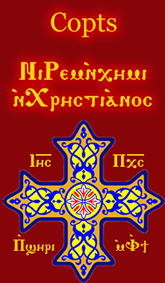
There have been many Coptic versions of the Bible, including some of the earliest translations into any language. Several different versions were made in the ancient world, with different editions of the Old and New Testament in five of the dialects of Coptic: Bohairic (northern), Fayyumic, Sahidic (southern), Akhmimic and Mesokemic (middle). Biblical books were translated from the Alexandrian Greek version.
Uncial 049, α 2. It is a Greek uncial manuscript of the New Testament. Paleographically it has been assigned to the 9th century.

Syriac is a dialect of Aramaic. Portions of the Old Testament were written in Aramaic and there are Aramaic phrases in the New Testament. Syriac translations of the New Testament were among the first and date from the 2nd century. The whole Bible was translated by the 5th century. Besides Syriac, there are Bible translations into other Aramaic dialects.

Papyrus 49 (Gregory-Aland), designated by 49, is an early copy of the New Testament in Greek. It is a papyrus manuscript of the Epistle to the Ephesians, surviving in a fragmentary condition. The manuscript has been palaeographically assigned to the 3rd century. It was probably a part of the same manuscript as Papyrus 65. It came from Egypt and was purchased for the Yale University Library. Textually it is close to the Codex Sinaiticus and Codex Vaticanus. The text of the manuscript has been published several times.
Francis Karl Alter (1749–1804), a Jesuit, born in Silesia, and professor of Greek at Vienna, was an editor of the Greek text of the New Testament. His edition was different from those of Mill, Wettstein, and Griesbach, because he used only the manuscripts housed at the Imperial Library at Vienna. It was the first edition of the Greek New Testament that contained evidence from Slavic manuscripts themselves, as opposed to Christian Frederick Matthaei's editions (1803-7), also claimed to be the first to contain evidence from the Slavic version of the New Testament.

Herman Charles Hoskier (1864–1938), was a biblical scholar, British textual critic, and son of a merchant banker, Herman Hoskier (1832–1904).
Huntington 17, bilingual Bohairic-Arabic, uncial manuscript of the New Testament, on a paper. It is dated by a colophon to the year 1174. It is the oldest manuscript with complete text of the four Gospels in Bohairic.
Huntington 20, is a Bohairic-Greek, uncial manuscript of the New Testament, on paper. Palaeographically it has been assigned to the 13th century.
Codex Marshall Or. 5, is a Bohairic-Greek, uncial manuscript of the New Testament, on a paper. Palaeographically it has been assigned to the 14th century.
Codex Marshall Or. 6, is a Bohairic-Greek, uncial manuscript of the New Testament, on a paper. It is dated by the Colophon to the year 1320.
British Library, Add MS 14448, designated by number 64 on the list of Wright, is a Syriac manuscript of the New Testament, on parchment, according to the Peshitta version. It is dated by a Colophon to the year 699 or 700. The manuscript is a lacunose. Gregory labelled it by 14e, 9a, and 8p . The codex is in the British Library as Add MS 14448.
Codex Marshall Or. 6, is a Bohairic, uncial manuscript of the New Testament, on a paper. Palaeographically it has been assigned to the 16th century.
George William Horner (1849–1930) was a British biblical scholar, an editor of the text of the New Testament in the dialects of the Coptic language.
Oriental MS 425, is a bilinguical Bohairic-Arabic, uncial manuscript of the New Testament, on paper, now in the British Library in London. It is dated by a colophon to the year 1308. The manuscript is lacunose.
Oriental MS 426, bilinguical Bohairic-Arabic, uncial manuscript of the New Testament, on paper, now in the British Library in London. It is dated to the 13th century. The manuscript is lacunose.
Oriental MS 1001, Bohairic, uncial manuscript of the New Testament, on paper. Palaeographically it has been assigned to the 12th century. Several leaves of the codex were lost. Horner designated the manuscript by siglum E2.
Add MS 5995, bilingual Bohairic-Arabic, uncial manuscript of the New Testament, on paper. It is dated to the fourteenth century. The manuscript has complex contents.
Oriental MS 1001, Bohairic-Arabic, uncial manuscript of the New Testament, on paper. It is dated to the year 1663. Horner designated the manuscript by siglum H3.
Lectionary 274, designated by siglum ℓ274 is a Greek manuscript of the New Testament, on paper. Palaeographically it has been assigned to the 16th century. It used to be known as Nanianus 202. The manuscript has complex contents.




